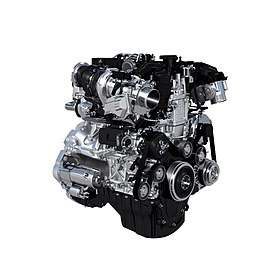Ingenium engine family
| Ingenium | |
|---|---|
 | |
| Overview | |
| Manufacturer | Jaguar - Land Rover |
| Production |
Jaguar Land Rover Engine Manufacturing Centre, UK 2015 - Present 2017 - Present |
| Layout | |
| Configuration | Inline-3 (Future), Inline-4, Inline-6 (Future) |
| Displacement | Inline 4: 2.0 L (1999cc) |
| Cylinder bore | 83 mm |
| Piston stroke | 92,3 mm |
| Cylinder block alloy | Aluminium alloy, cast iron liners |
| Cylinder head alloy | Aluminium alloy, integrated exhaust manifold |
| Valvetrain | 4 valves / cylinder, DOHC, chain-drive, electrohydraulic fully variable intake and exhaust valve lift system |
| Compression ratio |
Petrol - 10,5/1 Diesel - 15,5/1 |
| Combustion | |
| Turbocharger | Twin scroll turbocharger; ceramic ball bearings |
| Fuel system |
Petrol - 200bar solenoid direct injection, centrally-mounted; Diesel - 1,800 bar common rail injection; |
| Fuel type | Petrol, Diesel |
| Oil system | Wet sump, variable flow pump, computer-controlled oil pump |
| Cooling system | Water-cooled, computer-controlled water pump |
| Dimensions | |
| Dry weight | Up to 80 kg (180 lb) less than equivalent engines that are in use today |
| Emissions | |
| Emissions target standard | Euro 6 (b,d); SULEV |
| Chronology | |
| Predecessor |
Ford Duratec (Petrol); Ford Duratorq / PSA DW Family (Diesel); |
The Ingenium family is a range of modular engines produced by Jaguar - Land Rover, in both petrol and diesel variants. It uses modular architecture making possible to be produced in 3, 4, 5, and 6 cylinder versions (built around individual 500cc cylinders), depending on demand and requirements. The engines sourced from Ford were replaced by engines from Jaguar Land Rover's new Ingenium engine line from late 2015.
Ingenium’s design is configurable and flexible for longitudinal and lateral architectures and for front,rear, and all-wheel drive,together with auto and manual transmissions. Hybrid variants are set to be released in the future. Both single- and twin-turbo boosting solutions from Mitsubishi and BorgWarner are used. Particular emphasis has been placed on achieving exceptionally low internal friction, which is described as being 17% less than 2.2-L diesel predecessor.[1] "Other details include roller bearings on cam and balancer shafts instead of machined-in bearing surfaces, computer-controlled variable oil and water pumps, a split circuit cooling system enabling fast warm ups, a simplified cam drive system, crankshafts that are offset from the centre of the block and electronically controlled piston cooling jets to improve efficiency in the oil pumping circuit."[2]
In 2017 Jaguar Land Rover licensed the Multiair/UniAir electrohydraulic variable valve lift system[3] from Schaeffler Group, which Schaeffler in turn licensed from Fiat Chrysler Automobiles in 2001.[4] The system, developed by Fiat Powertrain Technologies, is a hydraulically-actuated variable valve timing (VVT) technology enabling "cylinder by cylinder, stroke by stroke" control of intake air directly via a gasoline engine's inlet valves.[5]
Engine family list
| Petrol | ||||||
|---|---|---|---|---|---|---|
| Engine ID | Displacement | Power@rpm | Torque@rpm | Year | Features | Applications |
| AJ200 | 1,999 cc (122 cu in) | 147 kW (200 PS) | 320 N⋅m (236 lb⋅ft) | 2016–present | DOHC I4, Turbocharger | Jaguar XE; Land Rover Discovery Sport |
| 1,999 cc (122 cu in) | 180 kW (250 PS) @ 5,500 | 365 N⋅m (269 lb⋅ft) @ 1,200 – 4,500 | 2016–present | DOHC I4, Turbocharger | Jaguar XE, XF, XJ, E-Pace, F-Pace | |
| 1,999 cc (122 cu in) | 221 kW (300 PS) @ 1500 | 400 N⋅m (295 lb⋅ft) @ 1500 | 2017–present | DOHC I4, Turbocharger | Jaguar F-Type, E-Pace, Land Rover Discovery; | |
| Diesel | ||||||
| AJ200D | 1,999 cc (122 cu in) | 110 kW (150 PS) @ 4,000 | 380 N⋅m (280 lb⋅ft) @ 1,750 – 2,500 | 2015–present | DOHC I4, Turbocharger, could achieve 68mpg and 119g/km CO2 | Land Rover Discovery Sport, Jaguar E-Pace |
| 1,999 cc (122 cu in) | 120 kW (163 PS) @ 4,000 | 380 N⋅m (280 lb⋅ft) @ 1,750 – 2,500 | 2015–present | DOHC I4, Turbocharger, could achieve 75mpg and 99g/km CO2 in Jaguar XE | Jaguar XE, F-Pace; Land Rover Discovery Sport | |
| 1,999 cc (122 cu in) | 130 kW (180 PS) @ 4,000 | 430 N⋅m (317 lb⋅ft) @ 1,750 – 2,500 | 2015–present | DOHC I4, Turbocharger | Jaguar XE, E-Pace, F-Pace; Range Rover Velar | |
| 1,999 cc (122 cu in) | 180 kW (240 PS) @ 4,000 | 500 N⋅m (369 lb⋅ft) @ 1,500 | 2015–present | DOHC I4, Twin Turbocharger | Jaguar XF, E-Pace, F-Pace; Land Rover Discovery; Range Rover Velar | |
See also
References
- ↑
- ↑ Editorial Team (2014-07-14). "Jaguar-Land Rover's Ingenium Engine Family: In Detail". Carblogindia.com. Retrieved 2018-02-14.
- ↑ JLR taps Schaeffler's fuel-saving system, sources say: JLR taps Schaeffler's fuel-saving system, sources say, accessdate: 14. helmikuuta 2018
- ↑ David Zoia (March 7, 2011). "Schaeffler Expects Other Takers for MultiAir Technology". Wards Automotive.
- ↑ "Fiat's Multiair engine wins Popular Science award". Popular Science via Allpar.com. November 17, 2010.
External links
- http://media.jaguar.com/news/2016/09/jaguar-land-rover-expands-ingenium-powertrain-family
- http://media.jaguar.com/news/2014/09/ingenium-world-class-engine-technologies-powering-new-jaguar-xe
- http://www.evo.co.uk/news/evonews/292819/jlr_launches_ingenium_engine_family.html
- https://blog.caranddriver.com/jaguar-land-rover-details-new-scalable-turbocharged-ingenium-engine-family/